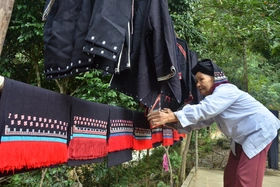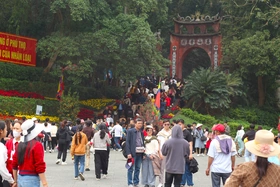{title}
{publish}
{head}
Although not as rare or expensive as river delicacies like giant catfish, hemibagrus, or bagrid catfish, the smooth-skinned cranoglanis (small river catfish), found abundantly in rivers across the province—especially in the Lo and Da Rivers—has long been regarded as a delicious and versatile ingredient.

With its rich flavor and multiple cooking methods, cranoglanis remains a favorite among diners, particularly those seeking authentic river cuisine in the Land of the Ancestral Kings. Dishes such as stewed, caramelized, grilled cranoglanis and especially cranoglanis cooked with “vo”—a specialty of the Lo River—offer a unique culinary experience that captivates food lovers.
There are many delicious dishes made from cranoglanis, such as braised cranoglanis, quick-stewed cranoglanis, cranoglanis stewed with tomatoes, and grilled cranoglanis. However, the most unique is cranoglanis cooked with “vo”, a specialty of the Lo River region. With its distinctive preparation method and the fishermen’s traditional cooking techniques, this dish offers an unforgettable and exceptional flavor for culinary enthusiasts.
There are two types of cranoglanis: farmed and wild-caught. The Lo River, particularly in Phu Ninh District, has many fish farms, but connoisseurs believe wild-caught cranoglanis has a superior flavor, despite farmed fish being larger and more visually appealing. Experienced diners can distinguish between the two by examining the color, size, and texture of the meat.

Cranoglanis meat is naturally yellow, with deeper hues indicating a wild origin or long farming periods. Farmed fish, often uniform in size (about three to four per kilogram), tend to have pale white skin and softer flesh, whereas wild fish offer firmer, richer meat.
“Vo vo” (or “vo”) is a small crustacean found mainly in the Bach Hac River junction (Viet Tri City) and the Red River. It only appears briefly in the second and third lunar months, surfacing in the early morning to molt and lay eggs before continuing its short life cycle.
Fishermen catch “vo” using nets, often during misty or changing weather. Once harvested, they are either sold fresh or vacuum-sealed and frozen for later use. Before cooking, the frozen “vo” is thawed, cleaned again, and stir-fried with fermented rice, tomatoes, scallions, and pork fat to enhance its aroma and flavor. Properly cooked “vo” is kept separate from the fish until serving to maintain its distinct taste.
Freshly caught cranoglanis is cleaned, its slimy outer layer removed, fins trimmed, and then cut into five to seven pieces per fish, depending on size. The fish is then marinated with shallots, garlic, fermented rice, fish sauce, salt, and chili for 15–20 minutes, allowing the flavors to infuse. The marinated fish is arranged on a large plate, ready to be cooked in the broth.
Once the pot of broth with cooked “vo” reaches a rolling boil, diners add the prepared cranoglanis, typically placing the head and tail in first to enrich the soup’s flavor. After simmering for three to five minutes, the fish and “vo” are served, garnished with fresh herbs, and enjoyed with hot broth poured into individual bowls.
The final dish presents a visually striking broth with an irresistible aroma that lingers in the memory of any food enthusiast. A standard serving for six people typically includes 1.5 kg of “vo” and 2–2.5 kg of cranoglanis, accompanied by fresh herbs, scallions, and rice noodles.

Priced between 250,000–300,000 VND per kilogram, cranoglanis can be purchased from fishermen or restaurants depending on quality. In dining establishments, the price is higher, and not all customers are familiar with this specialty. While not exceedingly rare, the unique combination of cranoglanis and “vo” has firmly established this dish as a signature delicacy of the Fatherland, leaving a lasting impression on visitors.
As spring arrives, there is no better way to savor the season than gathering with friends and family, raising a toast, and enjoying cranoglanis cooked witg “vo”. Alongside other traditional dishes like bánh tẻ, bánh chưng, bánh tai, and cá thính (fermented fish), this meal not only satisfies the palate but also serves as a beautiful reminder of the rich culinary heritage of Vietnam’s ancestral homeland.
Quoc Hoi

baophutho.vn With its rich ecological landscape, diverse culture, and unique ethnic customs, Binh Tuyen Commune is harnessing its natural and cultural...

baophutho.vn Phu Tho is shaping a new development vision to become a “new tourism growth pole” for the Northern Midlands and Mountainous region. With the...

baophutho.vn Since the 1960s, Lac Village in Chieng Chau Commune, Mai Chau District (Hoa Binh), has been selected by the government, ministries, and...

baophutho.vn As Vietnam’s tourism industry enters a period of strong growth, the need to restructure tourism products and orient strategic development has...

baophutho.vn Kim Boi Commune (Kim Boi District, formerly part of Hoa Binh Province) was established through the merger of Bo Town, Kim Boi Commune, and Vinh...

baophutho.vn From July 16 to 21, Phu Tho province actively participated in the Vietnam tourism promotion program in Republic of Korea, aiming to promote...

baophutho.vn There’s a place where time seems to stand still, where the hurried footsteps of the city cannot penetrate. It’s a place where people live in...

baophutho.vn The integration of Phu Tho, Vinh Phuc, and Hoa Binh has ushered in a new era for Phu Tho tourism. Within this expanded development space,...

baophutho.vn Hoa Binh Hydropower Reservoir has long been a favorite destination for tourists, admired for both its engineering significance and majestic...

baophutho.vn On the evening of June 21, the opening ceremony of the 2025 Vinh Phuc Tourism, Cuisine, and Craft Village Festival took place at the central...

baophutho.vn My Lung commune, Yen Lap district, has the potential to develop ecotourism and community tourism associated with the customs and practices of...

baophutho.vn Phu Tho, the ancestral land of the Vietnamese people, is home to a vast and invaluable cultural heritage. Of the nearly 260 annual festivals,...